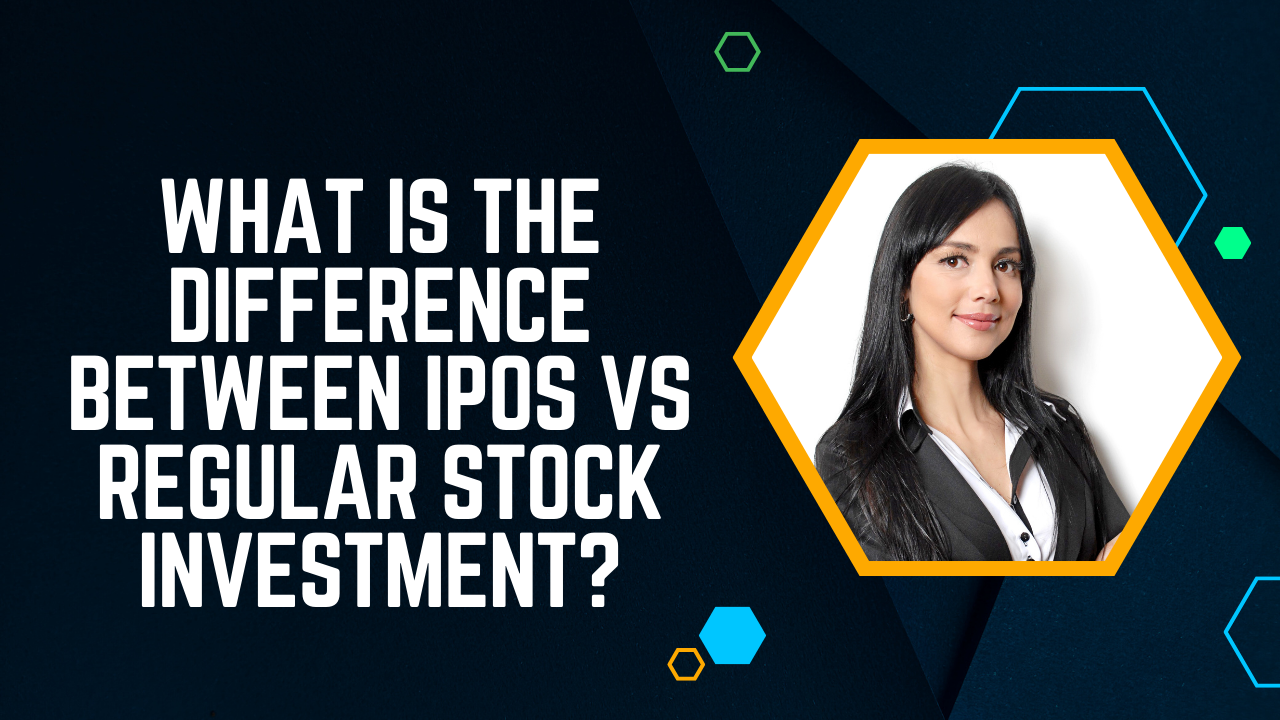An Initial Public Offering marks a pivotal moment in a company’s lifecycle when it transitions from being privately held to publicly traded on a stock exchange. During an IPO, a company issues its shares to the public for the first time, enabling investors to become shareholders. On the other hand, regular stock investment involves purchasing shares of already publicly traded companies through stock exchanges like the New York Stock Exchange (NYSE) or NASDAQ. Investors can buy and sell these shares on the open market, influencing the supply and demand dynamics that determine stock prices.

In this exploration of IPOs versus regular stock investments, we will delve into the key distinctions between these two methods of entering the stock market. From the initial offering process to the risks and rewards associated with each, understanding these differences is crucial for investors seeking to make informed decisions and navigate the dynamic world of stock market participation.
Introduction: Setting the Stage for Stock Market Entry
In the intricate landscape of financial markets, IPOs stand out as pivotal events, marking the transition of a company from private ownership to public trading. The Initial Public Offering process, encompassing regulatory approvals, valuation, and public offerings, is a significant undertaking for companies aiming to raise capital and expand their shareholder base. Investors participating in IPOs become early stakeholders, often gaining access to shares before they are widely available on the open market.
Conversely, regular stock investments involve buying and selling shares of already publicly traded companies. This established method allows investors to navigate the markets with a wealth of historical data and market information. The accessibility and liquidity of stocks in established exchanges provide a different avenue for investors to build and diversify their portfolios.
Defining IPOs: The Gateway to Public Trading
Initial Public Offerings (IPOs) serve as the inaugural chapter in a company’s journey into the public stock market, encapsulating a multi-faceted process, a significant shift in ownership dynamics, and a pivotal role in the overall lifecycle of a business.
The Initial Public Offering Process
At the core of an IPO is a meticulous and regulated process through which a privately held company transforms into a publicly traded entity. This intricate journey involves several key steps, including regulatory approvals, financial disclosures, and the determination of the offering price. The issuance of shares to the public, often accompanied by underwriting from investment banks, marks the culmination of this process, allowing investors to become early stakeholders.
Transition from Private to Public Ownership
The transition from private to public ownership is a defining feature of an IPO. Prior to going public, a company’s ownership is typically limited to a select group of private investors. Through an IPO, ownership extends to a broader spectrum of shareholders, including institutional investors and the general public. This shift not only brings about increased capital but also ushers in heightened scrutiny, transparency, and accountability.
Significance of IPOs in a Company’s Lifecycle
IPOs play a pivotal role in the overall lifecycle of a company. Beyond the immediate infusion of capital, going public enhances a company’s visibility, credibility, and access to additional funding in the future. It opens doors to new growth opportunities, mergers, and acquisitions, shaping the trajectory of the company in the competitive landscape of the stock market. The decision to go public is strategic, and the success of an IPO can be a critical determinant of the company’s future success.
Regular Stock Investments: Trading on Established Grounds
In contrast to the transformative process of Initial Public Offerings (IPOs), regular stock investments offer investors a more established and fluid avenue for participating in the stock market. This approach involves purchasing and trading shares of companies already publicly listed, providing investors with a wealth of historical data and market dynamics to inform their decisions.
Purchasing Shares in Publicly Traded Companies
Regular stock investments entail buying shares of companies that have already undergone the IPO process and are actively traded on established stock exchanges. Investors can choose from a vast array of companies spanning various sectors, each with its own risk profile and growth potential. The decision-making process involves analyzing financial reports, assessing market trends, and evaluating the long-term prospects of the chosen companies.
Accessibility and Availability on Stock Exchanges
Unlike IPOs, where shares are initially offered to a select group of investors, regular stock investments provide accessibility to a broader market. Shares are bought and sold on major stock exchanges such as the New York Stock Exchange (NYSE) or NASDAQ, offering investors a transparent and regulated platform. The availability of real-time pricing information and liquidity in these exchanges facilitates seamless transactions, allowing investors to enter and exit positions with relative ease.
Comparative Analysis: Key Distinctions Unveiled
Investors navigating the stock market encounter distinct characteristics when choosing between Initial Public Offerings (IPOs) and regular stock investments. The nature of ownership, supply and demand dynamics, and key considerations for decision-making illuminate the contrasting aspects of these two entry points into the financial markets.
One fundamental distinction lies in the nature of ownership stemming from these two approaches. IPOs introduce investors to a company in its nascent public phase, allowing them to become early stakeholders. In contrast, regular stock investments involve joining a company’s existing shareholder base. IPO participants may experience a unique sense of involvement in a company’s initial public journey, while regular stock investors engage in ongoing market participation with a diverse set of companies. Conversely, regular stock trading unfolds in an open market with constantly changing supply and demand forces influencing stock prices. The dynamic nature of these forces provides a fluid environment for trading and portfolio management.
Risks and Rewards: Navigating the Stock Market Landscape
IPOs carry inherent risks stemming from the unique nature of entering a company at its early public stage. Price volatility is a common concern, as the initial offering may experience significant price fluctuations in response to market sentiment. Additionally, limited historical data and a lack of established performance metrics make it challenging for investors to gauge the company’s stability and long-term viability. Regulatory hurdles, lock-up periods, and the potential for rapid market corrections add further complexity, requiring investors to carefully assess risk tolerance and conduct thorough due diligence.
Regular stock investments offer investors the potential for rewards through a more established and transparent market. Historical performance data, financial reports, and market trends provide a basis for evaluating potential gains. Investors can benefit from dividends, capital appreciation, and the opportunity to build a diversified portfolio with exposure to various industries and sectors. The liquidity of established stock exchanges facilitates ease of trading, empowering investors to capitalize on market opportunities.
Conclusion: Making Informed Decisions in Stock Market Engagement
In conclusion, the choice between Initial Public Offerings (IPOs) and regular stock investments represents a pivotal decision in an investor’s journey. Understanding the nuances of each approach is essential for making informed decisions in the complex stock market landscape. Whether opting for the potential growth and excitement of IPOs or the stability and transparency of regular stock investments, investors must consider their risk tolerance, investment goals, and market knowledge. By carefully weighing the risks and rewards, and balancing the dynamics of ownership and market participation, investors can navigate the stock market with confidence, positioning themselves for financial success and strategic wealth accumulation.
Also Read:
- Investment Taxation: Understanding Capital Gains, Dividends, and More
- The Impact Of Inflation On Investments
- What is the safest way to reduce investment risk?
- What are the major four assets of an investor portfolio?



